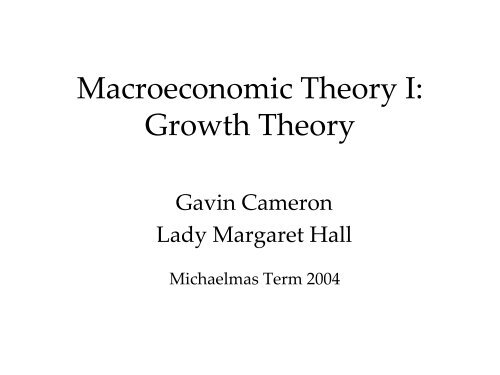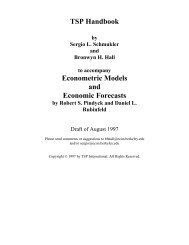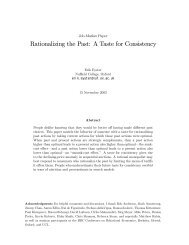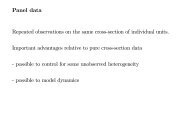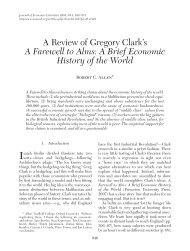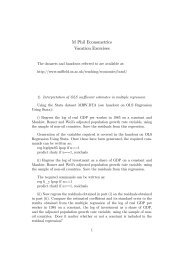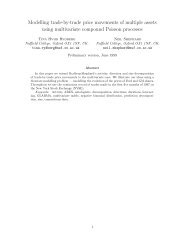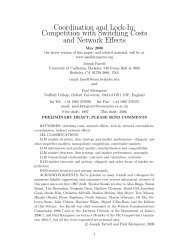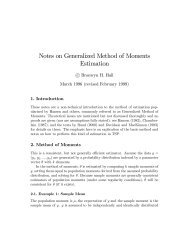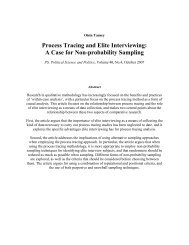Macroeconomic Theory I: Growth Theory
Macroeconomic Theory I: Growth Theory
Macroeconomic Theory I: Growth Theory
You also want an ePaper? Increase the reach of your titles
YUMPU automatically turns print PDFs into web optimized ePapers that Google loves.
<strong>Macroeconomic</strong> <strong>Theory</strong> I:<br />
<strong>Growth</strong> <strong>Theory</strong><br />
Gavin Cameron<br />
Lady Margaret Hall<br />
Michaelmas Term 2004
macroeconomic theory course<br />
• These lectures introduce macroeconomic models that have<br />
microfoundations. This provides a neoclassical benchmark,<br />
with optimising individuals and competitive markets. Of<br />
course, incomplete markets and imperfect competition are<br />
important phenomena in macroeconomics, but their effects are<br />
perhaps best understood as deviations from a wellunderstood<br />
benchmarks.<br />
• In this lecture series we will examine:<br />
• <strong>Growth</strong> <strong>Theory</strong><br />
• Investment<br />
• Competitive Equilibrium (Real) Business Cycles<br />
• New Keynesian Economics
the Ramsey model<br />
• Ramsey (1928) analysed optimal economic growth under<br />
certainty, by deriving the intertemporal conditions that are<br />
satisfied on the optimal consumption path that would be<br />
chosen by a central planner.<br />
• Intertemporal optimisation is usually analysed by use of a<br />
Hamiltonian function. This function maximises the present<br />
value of utility over an infinite horizon with respect to a state<br />
variable, a control variable, and a co-state variable (the shadow<br />
price of an extra unit of the state variable in terms of utility).<br />
This typically involves two first-order conditions and a<br />
transversality condition (to ensure that the state variable<br />
asymptotically approaches zero).
the OLG model<br />
• Another approach to intertemporal optimisation is not to<br />
assume that economic agents live forever, but to assume that<br />
they live in overlapping generations, as pioneered by Allais<br />
(1947), Samuelson (1958) and Diamond (1965).<br />
• These models imply that at any one time individuals of different<br />
generations are alive and trading with one another, and that<br />
future generations may be neglected by current generations.<br />
• The simplest possible such model, with just two generations alive<br />
at any one time, is used extensively in life-cycle consumption<br />
models.<br />
• Chapter 2 of Romer (1996) provides a very good introduction<br />
to both infinite-horizon and overlapping generations models.
a primer on growth theory<br />
• In the Solow model, growth is exogenous since it is driven by<br />
a rate of technical progress that is assumed to be constant.<br />
• In the 1980s, economists became interested in models where<br />
growth was endogenous, that is, was explained from within<br />
the system.<br />
• To do this, it is necessary to explicitly solve the consumer<br />
optimisation problem of the economy - the Solow model omits<br />
this by assuming a constant saving rate (although importantly<br />
it does allow factor substitution).<br />
• In practice, variables such as saving, human capital formation,<br />
and R&D should be endogenous.
the development of growth theory<br />
• Smith (1776), Malthus (1798), Ricardo (1817), Marx (1867)<br />
• growth falls in the presence of a fixed factor<br />
• Ramsey (1928), Cass (1965) and Koopmans (1965)<br />
• growth with consumer optimisation (intertemporal substitution)<br />
• Harrod (1939) and Domar (1946)<br />
• models with little factor substitution and exogenous saving rate<br />
• Solow (1956) and Swan (1956)<br />
• factor substitution, an exogenous saving rate, diminishing<br />
returns<br />
• Arrow (1962) and Sheshinski (1967)<br />
• growth as an unintended consequence of learning by doing
human capital models<br />
• One-Sector Models<br />
• with exogenous saving, diminishing returns: the Solow<br />
model<br />
• with exogenous saving and constant returns: the AK<br />
model<br />
• with consumer optimisation<br />
• Two-Sector Models<br />
• with exogenous saving: similar results to Solow model<br />
• with consumer optimisation: the Rebelo model<br />
• with consumer optimisation and no physical capital in<br />
education: the Lucas-Uzawa model
human capital models<br />
• What if production is not just a function of labour and capital,<br />
but also depends upon human capital?<br />
• Workers can be given the incentive to spend time learning<br />
new skills if those skills will receive higher rewards in the<br />
workplace.<br />
• Therefore, we can have a perfectly competitive production<br />
sector with human capital as an input into production.<br />
• The simplest way to do this is to treat human capital as just<br />
another form of capital (i.e. for it to be produced using the<br />
same production function as physical capital and output): a<br />
one-sector model.<br />
• The harder way to do this is to treat human capital as being<br />
produced by a different production function, presumably this<br />
production function will itself be relatively intensive in<br />
human capital: a two sector model.
a one-sector model (endogenous saving)<br />
• Assume a standard Cobb-Douglas production function with human<br />
capital input of H (i.e. the workforce L times the average quality of<br />
the workforce, h):<br />
(1)<br />
1<br />
Y AK α −α<br />
= H = C+ IK<br />
+ IH<br />
• Changes in capital stocks are given by:<br />
(2) K<br />
= IK<br />
−δK<br />
H<br />
= IH<br />
−δH<br />
• The equilibrium growth rate of C, Y, K and H can be shown to be<br />
* α (1 −α)<br />
(3) γ = (1/ θ).[A α .(1 −α) −δ−ρ]<br />
• Where 1/θ is the inter-temporal elasticity of substitution of utility<br />
and θ>0 (when θ is low, households care little about consumption<br />
smoothing) and ρ is the rate of time preference.<br />
• It should be apparent that there are constant returns to broad capital<br />
in this model, and it consequently behaves like the AK model. All<br />
variables grow at the rate of equation (3). Indeed, where<br />
nonnegative gross investment is allowed, the model has no<br />
transitional dynamics either since if K and H are unbalanced, they<br />
adjust discretely to their equilibrium values.
a two-sector model (exogenous saving)<br />
• Once again, consider the human-capital augmented model:<br />
α 1−α<br />
(4) Y=<br />
K (hL)<br />
• Where h is human capital per person. This evolves according<br />
to:<br />
(5) h = (1−u)h<br />
• Where (1-u) is time spent learning and u is time spent working<br />
. Re-writing this shows that an increase in time spent learning<br />
raises the growth rate of human capital.<br />
(6) h/h = (1−u)<br />
• This models works just like the Solow model where we call A<br />
human capital and let g=(1-u). Therefore, in this simple twosector<br />
model, a policy that leads to a permanent increase in<br />
the time spent learning leads to a permanent rise in the<br />
growth of output per worker.
the Lucas-Uzawa model<br />
• In the full Lucas-Uzawa model, the proportion of time spent<br />
learning is endogenous. Consider the following output and<br />
human capital accumulation equations:<br />
α 1−α<br />
Y= C+ K<br />
+δ K = AK .(uH) H<br />
+δ H= B.(1−<br />
u)H<br />
• To find the steady-state we look for a solution where u, K/H<br />
and C/K are constant. In which case, the common growth<br />
rate in steady-state of C, K, H, and Y is<br />
*<br />
(7) γ = (1/ θ)(B −δ−ρ)<br />
• If we define the following<br />
(8) ϕ≡[ ρ+δ.(1 −θ) ]/ Bθ<br />
• Then the steady-state proportion of time devoted to not<br />
learning is<br />
(9)<br />
*<br />
u =ϕ+ ( θ−1)/<br />
θ
dynamics of Lucas-Uzawa<br />
• In general, the growth rate of consumption in the model is<br />
(1 −α) −(1 −α)<br />
(10) γ<br />
C<br />
= (1/ θ).[ αA.u ( ω) −δ−ρ]<br />
• Where ω=K/H. Notice that (10) is inversely related to (K/H). Hence,<br />
the growth rate tends to rise with the amount of the imbalance<br />
between human and physical capital if human capital is abundant<br />
relative to physical capital (ωω*).<br />
• The model therefore predicts that the economy recovers faster from a<br />
war that destroys physical capital than from an epidemic that<br />
destroys human capital (the one-sector model predicts equally fast<br />
recoveries from either).<br />
• This is the result of the assumption that education is relatively<br />
intensive in human capital. If ω>ω*, the marginal product of human<br />
capital in the goods sector is high and so are wages. But the<br />
education sector is relatively intensive in human capital and therefore<br />
has a high cost of operation and low output.
ideas-based growth models<br />
• Linear Knowledge Production Function<br />
• Romer/Grossman-Helpman/Aghion-Howitt<br />
• Non-linear Knowledge Production Function<br />
• Jones/Kortum/Segerstrom<br />
• Linear Increasing Variety<br />
• Young/Peretto/Aghion-Howitt/Dinopolous-Thompson<br />
• Non-Linear Increasing Variety<br />
•Jones
the Romer model<br />
• One of the most influential new growth models is that of Romer<br />
(1990) which stresses the importance of profit-seeking research in the<br />
growth process.<br />
• There are three sectors in the full Romer model:<br />
• A competitive production sector;<br />
• A monopolistic intermediate-goods sector that produces<br />
particular capital goods using designs purchased from the<br />
research sector;<br />
• A monopolistic research sector where inventors race to invent<br />
and then receive a patent from the government.<br />
• The aggregate production function exhibits increasing returns since<br />
there are constant returns to L and K but ideas, A, are also an input.<br />
• Increasing returns require imperfect competition. Firms in the<br />
intermediate-goods sector are monopolists so capital goods sell for<br />
more than their marginal cost.<br />
• However, the profits of intermediate-goods firms are extracted by<br />
inventors and compensate them for the time spent in inventing.<br />
• There are no economic rents in the model; all rents compensate some<br />
factor input.
the basic Romer model<br />
• The aggregate production function takes the familiar form:<br />
α<br />
(11) Y=<br />
K (AL )<br />
Y<br />
1−α<br />
• There are constant returns to labour and capital but the<br />
presence of ideas (A) leads to increasing returns overall.<br />
Capital accumulates at the rate:<br />
(12) K<br />
= s Y−dK<br />
K<br />
• And the workforce grows at a constant rate:<br />
(13) L/L = n<br />
• Labour is used to either produce new ideas or to produce<br />
output<br />
(14) L + L = L<br />
A<br />
Y
ideas-based growth<br />
• Views of the knowledge production function:<br />
A<br />
A = δ L<br />
(15) R/GH/AH<br />
A<br />
(16) A<br />
= δ LA φ<br />
J/K/S<br />
A<br />
(17)<br />
A<br />
= δ LA<br />
λ<br />
A<br />
φ<br />
• δ is the productivity of each researcher; L A is the number of<br />
researchers<br />
• φ is the returns to the stock of ideas<br />
φ>0 increasing returns to ideas ‘standing on shoulders’<br />
φ
early endogenous growth<br />
Romer/Grossman-Helpman/Aghion-Howitt<br />
(18) Y = A σ<br />
L Y There are constant returns to rivalrous inputs<br />
and increasing returns to labour and ideas together, σ >0.<br />
New ideas are produced using research labour and the<br />
existing stock of knowledge:<br />
(19) where L A<br />
=sL and L Y<br />
=(1-s)L with 0
semi-endogenous growth<br />
Jones/Kortum/Segerstrom<br />
A<br />
= δ LA φ<br />
(21)<br />
A<br />
Where φ>0 increasing returns to ideas and φ
growth with increasing variety<br />
Young/Peretto/Aghion-Howitt/Dinopoulos-Thompson<br />
Suppose that consumption is a constant-elasticity of substitution (CES) aggregate of a variety<br />
of goods:<br />
i i<br />
(25)<br />
0<br />
where B is the number of different varieties of goods, Y i<br />
is the consumption of variety i and<br />
θ>1 is related to the elasticity of substitution between goods. The total number of varieties<br />
evolves over time according to:<br />
(26) B = L β<br />
in Y/P/AH/DT models, β=1 so that the variety of goods is proportional to the population.<br />
Under a range of assumptions about Y i<br />
, per capita output is given by:<br />
(27) c B A A<br />
with the R/GH/AH knowledge production function, the growth rate of A depends on<br />
research effect per variety, L A<br />
/B:<br />
(28) A<br />
substituting this into equation (27) yields:<br />
(29)<br />
= ⎡ ⎤<br />
⎢ ∫<br />
⎣ ⎥ ⎦<br />
B<br />
1/ θ<br />
C Y d<br />
θ<br />
g = θ g + σg = θβn + σg<br />
1−<br />
g = δ sL/<br />
B=<br />
δ sL β<br />
1−<br />
g = θβn+<br />
σδsL β<br />
c
the Jones (1999) model<br />
The Y/P/AH/DT models assumed that β=1. The intuition for this is<br />
that as the population grows, the number of varieties grows in<br />
proportion so that the number of researchers per variety stays<br />
constant. Therefore, there is no growth effect of scale.<br />
If β1, there is a negative<br />
growth effect of scale.<br />
In addition, we can also look at the effect of the J/K/S knowledge<br />
production function, A<br />
= δ LA φ , on the growth rate of<br />
A<br />
output in (29):<br />
(30)<br />
L<br />
1−β<br />
g = θβ n+<br />
σδ s<br />
c<br />
A<br />
1−φ<br />
This general models encompasses each of the three cases discussed<br />
earlier.
the Jones model<br />
β<br />
φ=1<br />
J/K/S<br />
Y/P/AH/DT<br />
Explosive or<br />
J/K/S<br />
β=1<br />
J/K/S<br />
Explosive<br />
R/GH/AH<br />
φ
optimal growth<br />
• In human capital models, the investment rate chosen by the<br />
representative agent is typically Pareto-optimal.<br />
• In ideas-based models, the investment rate chosen by the<br />
social planner is rather different from that chosen by the<br />
market. This is due to four distortions:<br />
• Current research affects the productivity of future research, but<br />
this is not rewarded – standing on shoulders.<br />
• Current research may also duplicate existing research and hence<br />
lower the productivity of research – stepping on toes.<br />
• Inventors cannot appropriate the entire consumer surplus due to<br />
their inventions – surplus appropriability.<br />
• Inventions may reduce the profitability of previous inventions –<br />
creative destruction.
intuition and growth models<br />
• To generate permanent growth in the absence of<br />
population growth (a growth effect of scale), a<br />
model must contain a fundamental linearity in a<br />
differential equation.<br />
• In the AK model this occurs in the production<br />
function and in the Romer model this occurs in the<br />
technology equation.<br />
• In the Young-Peretto model this occurs in the<br />
growth rate of varieties equation.<br />
• The Lucas model of human capital also contains<br />
such a linearity if u is assumed exogenous or when<br />
there are constant returns to H and K.
you can download the pdf files from:<br />
http://www.nuff.ox.ac.uk/Users/Cameron/lmh/


